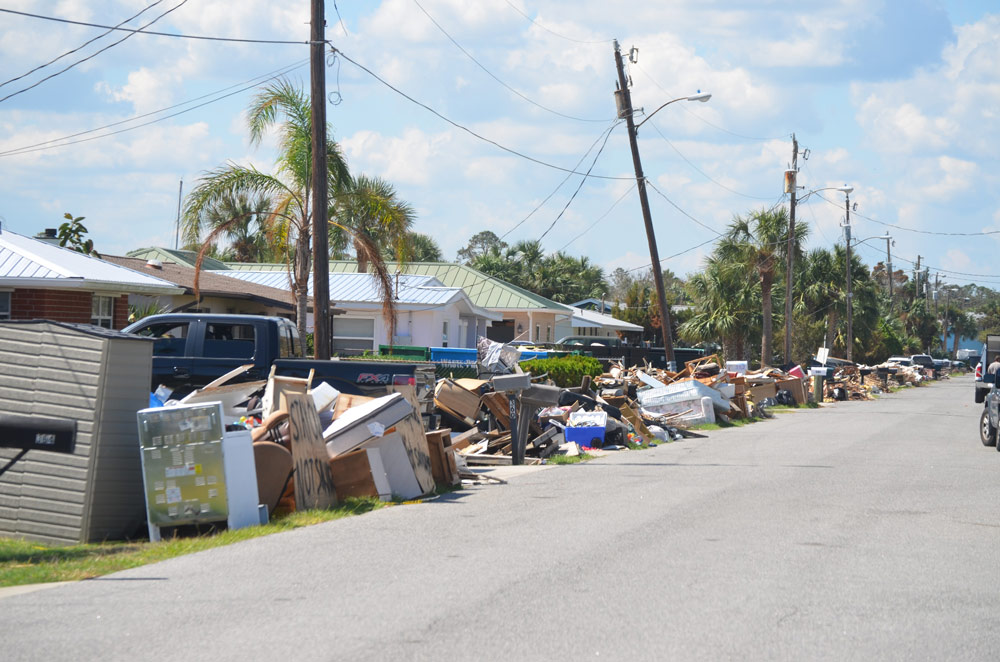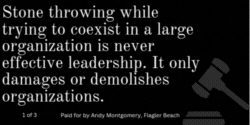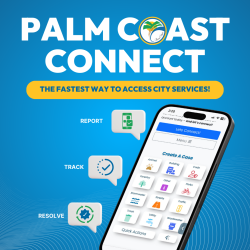
By Sabrina Valenti
Every summer brings the familiar joys of sunny weather, family barbecues, and beach vacations. But for Americans on the Gulf or Atlantic coasts, the daily weather forecast always comes with a constant thrum of worry — any small disturbance in the Atlantic has the potential to evolve into a major storm.
And as hurricane season gets underway, the palace intrigue, staffing cuts, and general upheaval of the Trump administration could have dire effects for people on these coasts.
We know hurricanes all too well. I was still in elementary school when we had to evacuate for Ivan and fret over Dennis in my small northwest Florida hometown. And I was in middle school in 2006, when refugees from Katrina were still pouring into my school district to enroll in my class — since their schools no longer existed.
I was in college at Louisiana State University when torrential rains flooded Baton Rouge in 2016. And just one year later, Hurricane Harvey stalled over southwest Louisiana, causing catastrophic flooding in that corner of the state.
I’m no stranger to natural disasters, and that’s exactly why I felt called to spend my career at the National Oceanic and Atmospheric Administration — one of many federal agencies that work together to both predict hurricanes and repair the damage when one strikes.
Each hurricane can feel like an act of God. Why this storm? Why now? Why my town, and why me? The longer I worked at NOAA, the more I came to appreciate how many experts work together to predict these storms and respond to them.
I wasn’t a storm chaser or a hurricane expert. I managed the budget for a major coastal wetland restoration program called the Coastal Wetland Planning, Protection, and Restoration Act.
CWPPRA is a piece of legislation spearheaded back in 1990 by Senator John Breaux of Louisiana. Five federal agencies work together to implement CWPPRA projects that build back land along Louisiana’s coastline, and NOAA alone has already restored 14,000 acres of coastal land since the law was passed 35 years ago.
Some of NOAA’s restoration projects protect the shrimp fisheries that are vital to Louisiana’s economy. Others restore habitats for migratory birds as they pass through Louisiana on their long journeys north or south. Some reinforce levees to protect crucial hurricane evacuation routes. And others still restore land that was lost in Hurricane Katrina.
 It’s hard to overstate what a great investment coastal restoration is. Dozens of other government employees and I worked hard every day to design effective projects and get money out the door so that local Louisiana businesses could build land on what used to be open water.
It’s hard to overstate what a great investment coastal restoration is. Dozens of other government employees and I worked hard every day to design effective projects and get money out the door so that local Louisiana businesses could build land on what used to be open water.
At first glance, it might seem like my program has nothing to do with hurricane preparedness. But as any Southerner knows about hurricanes, the further inland you are, the safer you are.
That land protects every Louisianan, especially the poorest residents who are least likely to evacuate when a storm makes landfall, and most likely to suffer the consequences. And when Louisiana is protected from storm damage, that’s money FEMA doesn’t have to spend to rebuild destroyed schools, homes, and highways.
But unfortunately, NOAA — and the CWPPRA program specifically — is among the victims of this administration’s slash-and-burn tactics. And I’m one of thousands of NOAA employees who’ve lost their jobs since the president took office in January.
Without my financial expertise, money isn’t getting out the door to rebuild South Louisiana. Cuts to FEMA loom on the horizon. And soon, hurricane season will ramp up ferociously. I worry about my hometown in Florida, the people of South Louisiana, and everyone in states affected by hurricanes.
It’s not too late to protect the federal workers who remain in their roles working on hurricane preparedness. Much of the damage from hurricanes this summer can be restored, but you can’t bring back the dead.
![]()
Sabrina B. Valenti is a Florida native and Louisiana State University graduate who has spent her career working in government budgeting and finance.
































Jake from state farm says
It seems you’re bearing the brunt of a bloated and inefficient bureaucracy that exists across nearly every federal agency. While some may label recent budget reductions as “slash and burn,” I see them as necessary steps toward fiscal responsibility. We need to critically assess what programs are truly essential and ensure that our tax dollars are being used wisely and effectively—not simply funneled into massive bureaucracies with little to no oversight or accountability.
Far too often, Congress allocates funding with little scrutiny over how those funds are actually used. Bureaucrats spend taxpayer money with limited transparency, and the results are rarely evaluated in terms of impact or necessity.
You mentioned cuts to FEMA—an agency that plays a vital role in disaster relief. That’s a valid concern. But it raises a deeper question: How do we justify millions of FEMA dollars being spent on individuals who entered the country illegally, while American citizens who have lost everything due to natural disasters are left to survive in tents through the winter? That kind of imbalance is not only unfair—it’s unacceptable. Our first obligation should be to those who are already part of our communities and have paid into the system.
This isn’t just about reducing spending—it’s about restoring priorities, demanding accountability, and making sure that government actually serves the people it claims to represent.
Marlee says
Jake…….
Did you know that the NOAA cuts, include a proposed 27% reduction in overall funding?………..threatening critical climate research, accurate weather forecasting…AND…
impacting everything from hurricane predictions which impact public safety, the economy, and national security.
Jake from state farm says
Marlee, it’s time to choose priorities.
Do we want to fund critical programs like NOAA, or do we keep pouring taxpayer dollars into questionable overseas projects and performative politics?
Consider this list of spending:
$1.5 million to promote Diversity, Equity, and Inclusion (DEI) in Serbian workplaces.
$70,000 for a DEI-themed musical in Ireland.
$47,000 for a transgender opera in Colombia.
$32,000 for a transgender comic book in Peru.
$20 million to create a Sesame Street-style show in Iraq.
$2 million for Moroccan pottery classes and marketing.
$2 million to promote tourism in Lebanon.
$15 million sent to Taliban-controlled Afghanistan for “reproductive health supplies,” including oral contraceptives and condoms.
$6 million to support tourism in Egypt.
$2.5 million for electric vehicles in Vietnam.
On top of this, U.S. taxpayers are footing the bill for congressional Democrats to travel to El Salvador — not to strengthen border security or trade — but to meet with a convicted MS-13 gang member, human trafficker, and domestic abuser who illegally entered the U.S., in an effort to bring him back.
This isn’t strategic foreign policy. It’s not humanitarian aid. It’s not even cultural diplomacy. It’s theater — expensive, taxpayer-funded theater.
If we truly care about protecting institutions like NOAA and ensuring domestic priorities are funded, we have to start drawing the line on wasteful, performative, and ideologically driven spending. When will you and the left start supporting the efforts about all the waste that is being cut and stop playing politics? At that point you will be taken seriously.
Every dollar spent on this kind of nonsense chips away at public trust and undermines serious needs here at home.
marlee says
Jake
I hope you guys living on the East Coast aren’t faced
with an Atlantic hurricane this season!
Good Luck with your ‘facts”
Marlee
Pogo says
@Cost of platforming mendacity and stupidity?
Immeasurable.
While changing the subject of these comments, may as well continue wandering:
For example
https://www.google.com/search?q=human+cost+of+destroying+usaid
And, four!
https://www.google.com/search?q=cost+trump+47+golfing
While you’re here
https://www.google.com/search?q=trump+family+2025+gain+from+self+dealing
And the next hurricane?
It is coming.
Where will you go?
Sherry says
FEMA:
.
FEMA is a US agency focused on disaster response and recovery within the United States and its territories. Its funds are allocated for disaster relief, individual assistance, and public assistance programs. These funds are not intended for tourism or other non-disaster related activities, even in US territories.
NOAA:
.
NOAA is a US agency that focuses on scientific research, weather forecasting, and ocean monitoring. While it does support coastal economies, including those reliant on tourism, its primary focus is on scientific advancement and environmental stewardship within the US and its territories. It does not directly fund tourism initiatives in other countries.
FEMA’s International Assistance:
.
While FEMA does have an International Affairs Division that manages partnerships and supports homeland security priorities, its role primarily involves coordinating assistance from other countries during domestic disasters and offering US assistance to other countries facing disasters. This does not involve using FEMA funds for tourism in other countries.
Jake from state farm says
Oh, Marlee—so just to be clear, are you saying the wasteful spending that could’ve gone to NOAA doesn’t actually exist? Or are we supposed to believe those brilliant expenditures are just far more critical than, say, climate research or weather forecasting?
And let me guess—you thought that the Biden we saw during his admin was the best Biden ever.
Sherry says
@ jake. . . Either post credentialed evidence for your ridiculous claims about FEMA and NOAA spending, or we will all continue to understand that you actually have very little credibility. Thanks!
Joe D says
For Jake from….
Jake…as usual you need to get your FACTS STRAIGHT….no “FEMA money” was pulled out of disaster funds to pay for housing and services for “illegal immigrants.” Those funds you are referring to were government funds that were approved for immigration services. The Biden administration, rather than set up ANOTHER BUREAUCRACY ($$$) to manage those funds (wasting taxpayer dollars), they decided that FEMA, ALREADY HAD the distribution expertise, and the availability of “boots on the ground” around the country to MANAGE that allotted money. FEMA was given that account to MANAGE and keep track of.
Another example would be if you were a business, and you had control over a budget for buying road repair equipment. You already had the system set up, and the budget was used as intended. Then say your boss decided to expand into home building equipment. Rather than hiring another “YOU” and duplicate all the accounting services by someone else, your boss decided to come to you and say. You already are handling the roadway equipment account, it makes sense for your department to also manage the HOME BUILDING ACCOUNT.
They are DIFFERENT business accounts, and you couldn’t MIX THE MONEY between the two accounts.
That’s what happened with FEMA… no EMERGENCY allotted funds were taken away from disaster victims, FEMA, just had the immigration services account money to manage also.
Unfortunately our current president failed to provide those FACTS, when bashing Biden during the election. I certainly hope you are prepared to go it “on your own,” in our next Florida disaster ( power outages, flooding, house damage, lack of drinking water and no food)… because our current illustrious leader thinks EVERY STATE should be able to manage disasters themselves with only a VERY REDUCED amount of Federal aid from FEMA in the future….so good luck!!!
I also want to apologize to the Flagler Live community for being “ABSENT” from comments the past 60 or so days. For some reason, due to software updates/issues and carrier conflicts, I have only been able to READ articles and comments, but have not been able to have a submitted comment go through to the server ( get a “bad transmission” error)….talk about raising my BLOOD PRESSURE!?! I’m going to have to contact the FlaglerLive team, to find out why the technology issues with my cell provider (randomly) prevent submissions. This was actually a SURPRISE, that I could have an open reply box actually open today, when I clicked REPLY. Of course, I haven’t hit SUBMIT …yet! 🤞🏻
Jake from state farm says
“@Sherry – If there were any outrageous claims, you would have cited them by now. It’s good to see that you prioritize spending on the listed items rather than supporting NOAA and FEMA. That’s really troubling, Sherry. But I suppose it’s not surprising since you believe Biden’s term was the best one yet. Still waiting for the ‘goosestepping Nazis’ and ‘internment camps’ that you and others on the far left predicted.”
Jake from state farm says
@Joe — Wow, welcome back! Flagler Love practically came to a standstill without your insight… we all barely made it through. Did you try to restart your computer??
Now, onto the important stuff — not that you’ll care. I don’t give a flying fig where the money magically appeared from. The fact remains that tax dollars — you know, the stuff scraped out of working citizens’ paychecks — were spent pampering people who strolled into the country illegally. Meanwhile, actual citizens — you know, the ones who built this place — froze in tents all winter because they lost everything, and veterans, those brave folks who literally put their lives on the line, are still sleeping on sidewalks.
But hey, as long as NOAA got their funding to “save the world,” it’s fine, right? Priorities, my friend. Priorities.
And you, Sherry, and the rest of the “compassionate” far-left chorus seem just thrilled to toss $20 million toward Sesame Street in Iraq, or maybe boost tourism in Lebanon. Because clearly what America needs right now is foreign puppet shows and Middle Eastern travel brochures, not food, shelter, or mental health support for struggling Americans. But again — priorities!
I get it though. As long as the money’s being spent in the name of your Best Biden Ever fantasy, it doesn’t matter if American citizens are literally being left behind. There’s really no point arguing with someone who thinks a collapsing economy and open borders are signs of a well-oiled administration. You’ve made your bed — I just hope you brought a blanket, because some of your fellow citizens are still sleeping on the ground.
Sherry says
@ jake. . . I have already asked you to provide any evidence that “I” have said anything interment camps, etc. No response from you because you have “nada/zip”! At this point, I’m just going to call you out as the “bold faced lier” that you are! If you keep “trolling” me, I’m going to make an official complaint to Flaglerlive management! All I asked you for is credentialed facts. Since you very often cannot provide them, then I will say that you are nothing but a misinformation monger.
Sherry says
For those who may not know, this is the second time ole’ jake has accused me of claiming trump would roll out goosestepping Nazis and implementing interment camps. I called him a liar the first time and asked him to prove it. . . zero response of course because I have done no such thing.
I guess this is jake’s fall back position anytime someone asks him to provide evidence for the complete misinformation he often posts. Again, jake has accused me of what amounts to nothing but ridiculous BS. To me that is trolling. If he continues, I will be lodging a complaint.
Jake from state farm says
@Sherry… Oh, and still no response about priority spending. How strange. Clearly, your silence must mean you’d rather see money funneled overseas to fund Sesame Street in Iraq and boost Lebanese tourism than, you know, actually support NOAA or anything that could possibly help the American people. Maybe getting our veterans off the streets?? Priorities, right? It’s truly inspiring to see such a clear sense of direction in your financial decisions.
You’ve made it crystal clear before that you think Trump and his supporters are nothing short of Nazis. I mean, you literally called him Hitler on repeat. With that you imply goose-stepping, internment camps, and the whole authoritarian package. So, tell me, when you’ve spent years painting that picture, where exactly does funding a government agency that serves the public like NOAA and FEMA fit into your world view? Or are those just inconveniently non-Nazi agencies?
But, hey, maybe you’re right—self-control might be the issue here. You’ve claimed in the past you weren’t going to respond to me, which I guess is some sort of “self-control” flex. Kudos, Sherry. But, back to the real question: what are your actual priorities when it comes to spending? Do you favor investing in NOAA and FEMA, or are we just going to keep pouring billions into Sesame Street in the Middle East and whatever other mind-numbing, wasteful nonsense we can find?
Again you believe it was the Best Joe Biden ever so there is that……
Sherry says
@jake at state farm. . . Know that I have, as promise, lodged an official complaint against you for your lies about me, and for your trolling. It’s pitiful that you simply cannot control your fear and anger against those who have a different life perspective than you do. However, if you think I’m going to simply sit back and let you attack and lie about me, you are absolutely mistaken.
I sincerely hope that you get the counseling you so desperately need to rejoin the reasonable “human race”. Until that time, I will simply ignore anything you post as you are not worthy of my treasured time.
Joseph Barand says
How come Trump’s weekly spending on golf trips never make the list? Per law he gets $19,000 for entertainment, $100,000 for travel, plus other budgeted item he ignores. Goggle what he is suppose to be limited by law. No. Wonder this fool has had 6 bankruptcies and how about him loosing at least 3 casinos. He proves his inability to manage money but I guess his supporters just don’t care.
Joe D says
Gee, Jake from State Farm…
I see you have followed our current DISASTER IN CHIEF in his behavior of PERSONALLY attacking others who point out errors in your facts and don’t agree with your points of view. But thank you for the IDIOTIC comment about rebooting my computer (REALLY)…clearly IT expertise is another one of your “Perceived” talents (NOT).
As far as the FlaglerLive Community missing my “INSIGHT,” during my time “away” during technical issues, I consider myself an active Community member ( the physical community, not just the virtual FlaglerLive Community), and yes, in the past, I’ve received enough “likes” and positive posted comments on this site, to feel that my attempts to be factual and balanced have not fallen on deaf ears (except maybe your own).
As for your personal attacks towards others in this space, I HOPE that other than a REMINDER about being CIVIL in your comments, that your charged thoughts aren’t censored too much…because so many of your comments triggered LIVELY site responses (free speech generally gets accepted until it becomes LIBEL…that means WRITING lies about someone in an attempt to discredit them). You really generate QUITE the impression with your posts!
And as far as Nazis and goose-stepping goes. It DOES seem like TRUMP and his associates have adopted the NAZI WW II playbook:
-choose a SCAPEGOAT (immigrants rather than Jews this time)
-set the PRESIDENT’S orders above the COURTS (playing out daily in the news)
-Silence the journalists (current SANCTIONS against the White House press corps journalists/frivolous lawsuits against journalists reporting uncomfortable TRUTHS)
-When you lie, make it a BIG LIE…so everyone will think you are telling the truth ( kind of goes without saying , also DAILY in the MAGA MEDIA)
-Kill/jail all the Lawyers (thankfully the current administration is just sanctioning law firms and taking away legal access to defend their clients in actions against the current administration…aimed at legal firms who participated in prior litigation, both private and governmental invoking Donald Trump)
-Use paid neighborhood informers to make allegations (true or not), against neighbors ( the new Immigration policy allows for paid informers to “out” illegal immigrants).
-Develop a secret police to instill fear in the population, with little or no TRANSPARENCY /ACCOUNTABILITY and following the rule of law—the “SS troops” ( in the modern scenario they are called “ICE”…if you don’t believe me…look at some of the door camera footage of some of the ICE arrests)
-Finally: declaring MARTIAL LAW (fortunately we are not there…YET)
In my opinion, the Nazi references, suggested by WHOMEVER (?!?), aren’t too far off base.
Jake, I HOPE you stick around…FREE SPEECH is such a cherished RIGHT in the USA….at least at the MOMENT, but clearly dying FAST in the current administration.
To Sherry: BRAVO for standing up to personal BULLYING!
Nobody says
Jake is absolutely right—and while some here seem more interested in tone policing or deflection, the facts are on his side.
Let’s deal with NOAA first. Under the Biden administration, the FY2025 federal budget proposal included a 27% cut to NOAA’s discretionary funding, threatening vital programs like hurricane forecasting, coastal resilience, and climate data collection—right as we face increasingly intense storm seasons. [Source: Congressional Budget Justification, NOAA FY2025].
Meanwhile, the same federal budget included over $40 billion in foreign aid, some of which, yes, includes things like $2 million for Moroccan pottery promotion, $15 million to Taliban-controlled Afghanistan for “reproductive health supplies”, and millions more for overseas DEI and tourism programs. These are not conspiracy theories. They’re pulled directly from U.S. State Department and USAID grant databases and congressional spending reviews. Feel free to check.
NOAA, FEMA, and disaster-preparedness programs are being gutted while these cultural pet projects and “soft diplomacy” grants abroad remain protected. If the argument is that these international efforts are somehow more important than storm tracking in Florida or flood mitigation in Louisiana, that’s a hard sell—especially to the American citizens getting crushed by hurricanes or displaced in FEMA trailers.
Critics love to talk about “false claims,” but Jake’s core point is undeniable: taxpayer priorities are broken. We can fund a transgender-themed opera in Colombia or a puppet show in Iraq, but the people rebuilding after Category 4 storms have to wait for scraps? Veterans are homeless, cities like Flagler Beach are flooding, but the bureaucracy marches on?
If you don’t want to believe Jake, look at the Government Accountability Office or OpenTheBooks.com. The waste is real. The misplaced priorities are real. And the deflection from these truths—by those with nothing to counter them but snark—is telling.
Jake’s pointing out a hard truth: when government loses focus on serving its own people, especially during crises, it loses legitimacy. The sooner we fix that, the better off we’ll all be.
I hope you get the help you need with TDS….